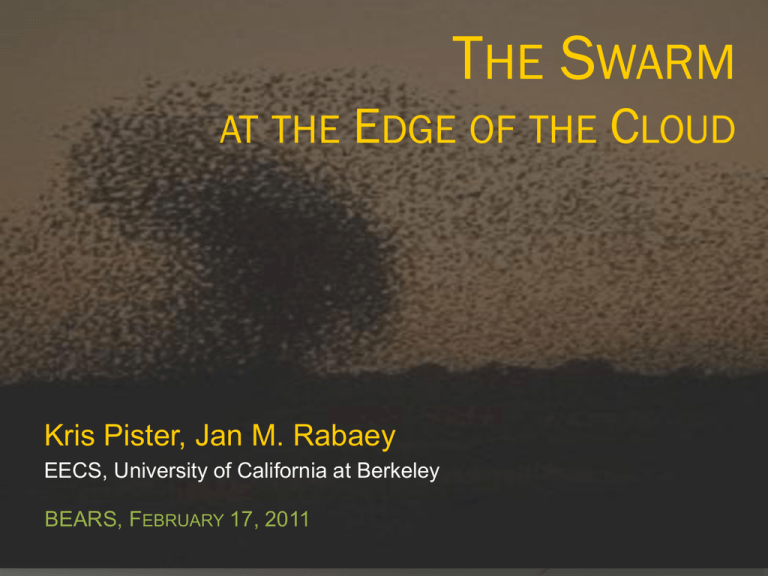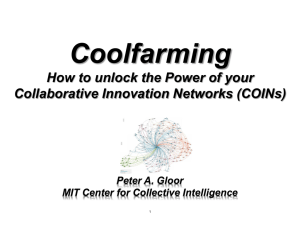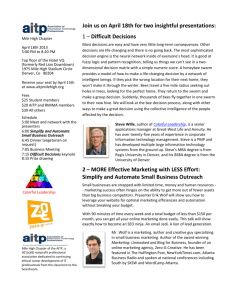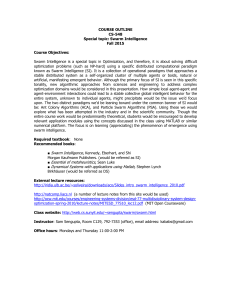T S HE WARM
advertisement

THE SWARM AT THE EDGE OF THE Kris Pister, Jan M. Rabaey EECS, University of California at Berkeley BEARS, FEBRUARY 17, 2011 CLOUD Vision 2010 1990 Question: What Happens to Computers if Wireless Connectivity Becomes Ubiquitous? [R. Brodersen, ISSCC keynote 1997] The UCB Infopad Project (1992-1996) The Birth of the Wireless Tablet Vision 2010: The Mobile as Gateway to the Cloud Primary intent: interact with the Internet Vision 2010 1997 Question: What happens if sensors become tiny and wireless? Vision 2030 Integrated components will be approaching molecular limits and/or may cover complete walls - Every object will have a wireless connection - The “trillions of radios story” will be a reality - The ensemble is the function - - Function determined by availability of sensing, actuation, connectivity, computation, storage and energy - This brings virtualization to a new level The Swarm at The Edge of the Cloud TRILLIONS OF CONNECTED DEVICES Infrastructural THE CLOUD core THE SWARM [J. Rabaey, ASPDAC’08] The Swarm Perspective Moore’s Law Revisited: Scaling is in number of connected devices, no longer in number of transistors/chip The functionality is in the swarm! Resources can be dynamically provided based on availability It’s A Connected World Time to Abandon the “Component”-Oriented Vision [J. Rabaey, MuSyC 2009] Swarm Potentials “Tiny devices, chirping their impulse codes at one another, using time of flight and distributed algorithms to accurately locate each participating device. Several thousands of them form the positioning grid … Together they were a form of low-level network, providing information on the orientation, positioning and the relative positioning… It is quite self-sufficient. Just pulse them with microwaves, maybe a dozen times a second …” Pham Trinli, thousands of years from now Vernor Vinge, “A Deepness in the Sky,” 1999 One Vision: CyberPhysical Systems Linking the Cyber and Physical Words [H. Gill, NSF 2008] Another One: BioCyber (?) Systems Linking the Cyber and Biological Worlds Examples: Brain-machine interfaces and body-area networks What Bio-Cyber-Physical Systems Enable… Vision 2030: The Age of the “UnPad” Computers and mobiles to completely disappear! The Immersed Human Always-available augmented real-life interaction between humans and cyberspace, enabled by enriched input (sensory) and output (actuation, stimulation) devices on (and in) the body and in the surrounding environment The Disassembled Infopad What it Takes … Seamless collaboration of huge numbers of distributed nodes – “the swarm” Huge communication challenges Large numbers of multimedia data streams Combined with critical sensing and control data Varying degrees of availability, mobility, latency, reliability, security, and privacy Tremendous computational power Generating true real-time enhanced reality Mostly provided by the “cloud” – but latency issues dictate locality Distributed storage All within limited energy budgets The Swarm “Playground” Distributed Resources Communication (Spectrum) Computation Sensing Actuation Storage Energy The Swarm Operating System Dynamically trading off resources The “Unpad” Services and Applications Utility Maximization “What matters in the end is the utility delivered to the user” A continuously changing alignment (environment, density, activity) Making it Happen: “The Swarm Lab” An experimental playground for the exploration and realization of innovative and disruptive swarm applications Creation of the most advanced “swarm nodes”, exploring post-Moore technologies and manufacturing strategies combined with ultra-low power implementation fabrics and architectures for both computation, communication, storage, sensing and energy provision Multi-disciplinary in nature, the lab combines researchers from diverse backgrounds covering the complete spectrum from application over integration to technology and materials. Seeded by a major donation by Qualcomm, Inc Opportunity: A Whole Floor in Cory Hall POST-SILICON LAB Enabled by the move of the microlab to Sutardja-Dai Hall (Marvell Lab) The Post-Si Lab Innovative Electronics Materials and Device Technologies for Future Integrated Systems Roll-2-Roll Processing Utilizing our strengths in novel electronic materials (e.g, III-V on Si and plastics, nanostructures, graphene, organics), and devices for exploring a broad range of alternative technologies to the traditional silicon scenario. Developing an entirely new processing platform for integrated electronics and sensors, and energy harvesting systems. PV rolls Interfacing EE and chemistry through materials innovation. XoY Electronics: All-on-All Bendable, Wearable, Paper-Like Electronics & Sensors Materials, Devices, and Processing Technologies for Conformal Integrated Systems Berkeley Approaches and Technologies: gravure/ink jet printing of semiconductors & conductors printing of nanoscale semiconductors Printed FETs, Passives, and Energy Devices on Bendable, Flexible Substrates XOI – Heterogeneous Integration of Compounds on Si CMOS Extension and CMOS Plus Ni ZrO2 InAs 15 nm SiO2 Si 50 nm ZrO2 InAs Need for Heterogeneous Integration Wide spectrum of materials with tunable electrical and optical properties High drift velocity – Low power (green) electronics Added functionality – e.g., integrated sensors, detectors, LEDs, lasers, …. on Si Fabrication Features for XOI III-V integration on Si/SiO2 substrates – Wafer Bonding / Epilayer Transfer Nanoscale doping of contacts – Monolayer Surface Doping High quality interfaces – Surface passivation Device Advantages of XOI 5 nm SiO2 Example System: Ultrathin body InAs-on-insulator MOSFETs Enhanced electrostatics Reduced leakage currents Compatibility with CMOS/SOI Generic device architecture for different material systems The Nano-Mechanical Lab Harnessing the Benefits of Scaling in Domains Beyond the Electronic Explore the efficacy by which scaling and circuit/system level design using nonelectronic (e.g., mechanical, thermal, fluidic, chemical) bases enable new capabilities and applications Realize needed swarm functions (e.g., sensing, communication, …) with high efficiency, low energy consumption, high specificity, and low false alarm rates MEMS Rotary Engine Power Generator NEMS RF Signal Processor Cyborg Beetle Micro Optical Sensor “Smart Dust” Micro/Nano Sensors Low Power, mm-accurate Ultrasonic Rangefinding (Boser, Horsley) CMOS Processing Chip Aluminum Nitride piezoelectric membrane Pulse-echo range measurement MEMS transceiver Ultrasound Wave f = 200kHz • Low Power: ~100 microwatts • Millimeter (3σ) accuracy over >0.7 meter range • Tiny (1mm3) volume Micro-cyborgs Michel Maharbiz Nanosatellites Luke Lee Group 2. Imaging FeO 1. Targeting 3. Gene delivery A swarm of robots to do our bidding The New Photonics Lab Integrating Photonics for Sensing, Communication and Power Generation Solar cells with unprecedented efficiency for energy generation/harvesting New Materials to create high quality thin films Nanoscale lasers and LEDs integrated on Si or plastics New display using nano-optomechanic devices Sub-wavelength optics for ultra-low power sensing and interconnects Wearable micro-LIDAR for instant 3D mapping Solar Cells Nanolasers Emissive Display Nano-Photonics for High Efficiency PV and LED Nano-synthesis enabling integration of everything on anything Nanolaser on MOSFET enabling massive opto and electronics and integration InP on Si GaAs on Si GaAs on Sapphire GaAs on poly-Si Nano-grass solar cells on poly-Si with wide-angle light-trapping design for high efficiency on any substrate Modeling and Simulation of Subwavelength Optics InGaAs Nanograss Poly-Si Metal substrate Connie Chang-Hasnain Group 200 nm The Swarm Hive An Incubator for Swarm Applications and Platforms Integrating our strengths in advanced sensing, innovative post-silicon substrates and packaging, ultra-low power computing and communications, wireless links and networks, and distributed systems … To create entirely novel swarm solutions to applications such as the Unpad, health care, smart energy management, security, … In a multi-disciplinary open lab-workspace setting In close collaboration with other Berkeley Labs such as CITRIS, BWRC, BSAC, COINS, Marvell Lab, … In Summary … The Laws of the Swarm In a connected world, functionality arises from connections of devices. Largest efficiency gain obtained by dynamically balancing available resources: computation, spectrum and energy. The dynamic nature of the environment, the needs and the resources dictate adaptive solutions. No one wins by being selfish. Cooperation and collaboration are a must. Swarm in 2020 If We’re Lucky: Almost Certainly: Sensornets extend our Printed systems senses XOI, XOY Efficient solar everywhere Micro robots extend our muscles Photons in every chip The cloud extends our No Watt unmonitored brains Instrumented cities Instrumented body





